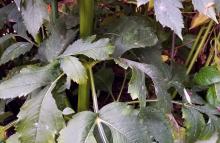Cause Golovinomyces cichoracearum (formerly Erysiphe cichoracearum) has been reported from Washington and the disease has been observed in Oregon. Golovinomyces spadiceus has also been reported from the United States. It is not considered a large problem in the US but has been troublesome in other areas of the world (with different powdery mildew fungi). Weather that produces high humidity but dry leaves favors this fungus. It is a highly specialized pathogen that forms a close association with the host. Conditions that favor the host also favor the pathogen. Much of the fungus remains outside infected plant parts where it grows on the surface but sinks root-like structures called haustoria into plant cells to obtain nutrients. The white growth seen is composed of both mycelium and spores of the fungus.
Symptoms Grayish white, powdery spots generally develop over the entire dahlia leaf surface forming a cobwebby mat of hyphae. Conidia production gives it a cottony appearance. Severely affected leaves become distorted and may fall prematurely.
Cultural control
- Plant resistant cultivars such as Dahlinova or Dahlinova Hypnotica.
- Space plants for good air circulation.
- Remove and destroy severely infected plants or plant parts.
Chemical control Fungicides will do best when used before symptoms develop. Few materials have good eradicant activity. Use at 7- to 14-day intervals; using shorter intervals when environmental conditions favor disease development. Alternate or tank-mix products from different groups that have different modes of action. Limit the use of any one group during the growing season.
- Armada 50 WDG at 3 to 9 oz/100 gal water. Do not use a silicone-based surfactant. Not for nursery or greenhouse use. Group 3 + 11 fungicide. 12-hr reentry.
- Disarm 480 SC at 1 to 4 fl oz/100 gal water. Group 11 fungicide. 12-hr reentry.
- Eagle 20 EW at 6 to 12 fl oz/100 gal water. Group 3 fungicide. 24-hr reentry.
- Fame SC at 1 to 4 fl oz/100 gal water. Group 11 fungicide. 12-hr reentry.
- Heritage at 1 to 4 oz/100 gal water plus a non-silicone-based wetter sticker. Group 11 fungicide. 4-hr reentry.
- Insignia SC at 3 to 6 fl oz/100 gal water. Do not use with organosilicate-based adjuvants. Use preventively only. Group 11 fungicide. 12-hr reentry.
- Myclobutanil 20 EW T&O at 6 to 12 fl oz/100 gal water plus spreading agent. May observe a PGR effect. Group 3 fungicide. 24-hr reentry.
- OHP 6672 4.5 F at 10 to 20 fl oz/100 gal water. Group 1 fungicide. 12-hr reentry.
- Ortho Rose & Flower Disease Control at 2 fl oz/gal water. Group 3 fungicide. H
- Pageant at 6 to 12 oz/100 gal water. Do not use with organosilicone-based adjuvants. Group 7 + 11 fungicide. 12-hr reentry.
- Pipron at 4 to 8 fl oz/100 gal water. For use only in greenhouses. Group 5 fungicide. 12-hr reentry.
- Regime at 20.5 to 45.7 fl oz/A. Reapply if rain occurs within 12 hours of original application. Group BM01 fungicide. 4-hr reentry.
- Safer Brand Garden Fungicide (Ready To Use 0.4% sulfur) thoroughly sprayed over the entire plant. Do not use when the temperature is over 85°F or within a few weeks of an oil spray. H
- Seido at 4 to 5 fl oz/100 gal water plus an adjuvant. Group 50 fungicide. 4-hr reentry.
- Spectracide Immunox Multi-Purpose Fungicide Spray Concentrate for Gardens at 1 fl oz/gal water. Group 3 fungicide. H
- Terraguard SC at 4 to 8 fl oz/100 gal water. Group 3 fungicide. 12-hr reentry.
- Thiolux (80% sulfur) at 3 to 10 lb/A. Group M2 fungicide. 24-hr reentry. O
Reference Mukhtar, I., Mustaq, S., and Khokhar, I. 2013. First report of powdery mildew on Dahlia (Dahlia variabilis) caused by Golovinomyces cichoracearum in Lahore, Pakistan. Australasian plant disease notes 8:1-3.


